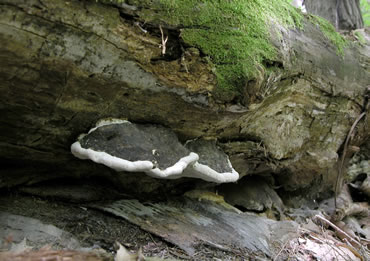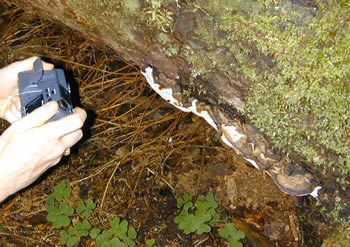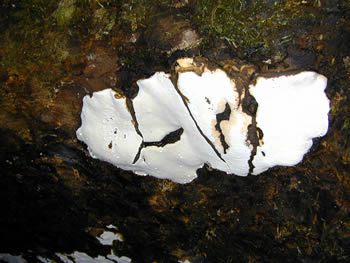Heterobasidion irregulare
Scientific name: Heterobasidion irregulare Garbel. &
Otrosina
Derivation of name: Heterobasidion means with "with
different or variable basidia"; irregulare means "irregular"
in reference to the shape of the pores.
Synonymy: Polyporus irregularis Underw., Fomes
annosus (Fr.) Cke.,Heterobasidion
annosum (Fr.) Bref.
Common names: Conifer-base polypore.
Phylum: Basidiomycota
Order: Russulales
Family: Bondarzewiaceae
Occurrence on wood substrate: Parasitic and saprobic;
solitary or overlapping at the base of stumps, on dead trunks
and logs, and on the roots of living conifers, rarely on
deciduous trees; year-round.
Dimensions: Caps up to 15 cm wide, 9 cm long, and 5 cm
thick. Caps sometimes fusing into longer rows. Fungus
sessile, effused-reflexed, or resupinate.
Upper surface: Young caps grayish-white, becoming gray-
brown to blackish-brown, sometimes reddish-brown, often
with a cream-colored margin; rough and irregular;
concentrically zoned or furrowed; hairy to glabrous.
Pore surface: White to cream; pores 2-5 per mm.
Edibility: Inedible.
Comments: This species is listed as Heterobasidion
annosum in many field guides. H. annosum, however, was
demonstrated to be a European species which does not
occur in North America. H. irregulare may resemble some
specimens of Fomitopsis mounceae. F. mounceae,
however, usually occurs higher up on the tree, has a
thicker and smoother cap, and, internally, has evenly
(distinctly) stratified (layered) tubes and flesh that reddens
in KOH. The flesh ofH. annosum does not redden in
KOH and, if not growing as an annual, its tubes are
described as indistinctly stratified.
More information at MushroomExpert.com

Figure 1. Heterobasidion irregulare often has a wavy
margin.
Photo
© Dianna Smith.

Figure 2. Several caps have fused laterally.
Heterobasidion irregulare is a major root rot
pathogen of conifers in North America.
Photo © Tom Volk.

Figure 3. The creamy white pore surface of
Heterobasidion irregulare.
Photo © Tom Volk.